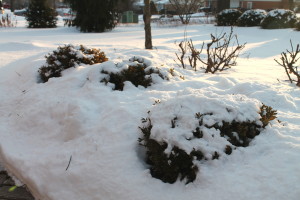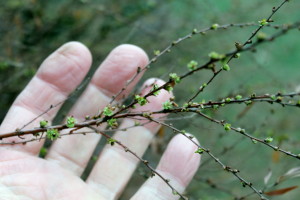Not So Bad of a Winter?
March 8th, 2016
Now that the 30 inches of snow is gone and washed into the water table, we’re getting a good look at how our landscape plants fared over winter.

All of that snow is keeping cold wind off of these boxwood leaves.
From what I’m seeing, it looks like things came out in good shape – at least better than the past two cold winters.
Extreme as it was, all of the late-January snow turned out to be good plant insulation. It didn’t seem to tear down a lot of branches or sag a lot of evergreens as ice storms and heavier snows often do. (For more on this, read my Pennlive.com “One Plus to All of the Snow” article from January.)
What it DID do, though (besides cost us $55 million statewide to remove from roads), is protect leaves and tender branch tips from cold winter winds.
Buried under 2 feet of snow, things like hydrangea flower buds and nandina leaves don’t wind-burn or die as they do when exposed to sub-zero wind blasts from a polar vortex.
We got down into the single digits for a little this winter, but we didn’t get hammered by any prolonged super-cold spells.
What worried me more was that incredibly warm December that pushed plants much farther along than they should’ve been heading into January.
I saw bulb shoots poking up as if it were March, rose and lilac buds elongating, and even heard some people say their forsythias and flowering almonds were blooming already. (Read my Pennlive.com December post about plants blooming prematurely.)
When that happens and you get a sudden return to reality in January, prematurely developed growth can be more susceptible to injury and death.
Fortunately, temperatures didn’t nosedive until that protective snow storm came along.

Live leaf buds are showing already on this spirea.
Most of the buds and stems I’m seeing look like they’re alive and green inside. That means plants should leaf and flower normally this spring, although it could happen a little earlier than usual due to December’s push (especially so if this week’s warm temperatures are a forerunner to a quick spring).
Already, some of the season’s earliest bulbs, such as winter aconite, crocuses and snowdrops, have shot up and bloomed nicely in many yards. Other bulb foliage is poking up on cue.
What won’t fare as well are shrubs that advanced into the bloom stage in December.
Once those buds open, they’re done for the season. Forsythias and flowering almonds, for example, can’t quick grow another set of flower buds to replace the ones that already flowered back in December.
The possible diminished flower show should affect only the earliest bloomers like those. Mid- to late-spring and summer bloomers have the “good sense” to hold back and develop when the conditions really are right. They’re less likely to get faked out by winter warm spells.
I don’t foresee any problem with this year’s bloom of perennial flowers. They’ve all been safely nestled under a bed of snow for weeks and should develop normally.
The only one that might look a little worse for wear is Lenten rose (Helleborus), which is an exceptionally early bloomer that generally was flowering around here in early January.
The flower-petal margins of some of these are looking brown and ragged, although the flowers themselves seem to be alive.
I have one called Pink Frost that was starting to push fat flower buds back in January before going into “suspended animation” for weeks under the snow. It’s about to bloom profusely.
If you haven’t already, get out there and inspect your botanical troops. You might be pleasantly surprised.







